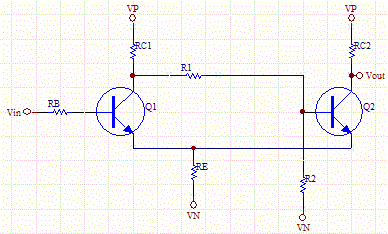Transistor Schmitt Trigger Circuit
The Schmitt-trigger is a circuit which creates hysteresis and which is useful in digitizing an analog signal into a digital signal of either high or low. The hysteresis makes inputs more immune to noise. The input must surpass a low threshold voltage before the output goes low, and likewise the input must exceed a high level threshold before the output goes high. The output stays at the previous level, when the input is in the intermediate range, between the high and low thresholds. Many digital circuits and microprocessor inputs use Schmitt-trigger inputs.
Comparators, op-amps, and some TTL circuits such as the 74XC14 can be used to generate hysteresis, but often it is desirable and cost effective to use a discrete transistor solution. In the circuit below the upper threshold is set by R1 and R2, and the lower function is set by RE.

Schmitt-Trigger Schematic
CASE 1: Vin=0, Q1 is off and Q2 is On, Vout= VE
VB2= R2*VP/(RC1+R1+R2)
CASE 2: Vin= VP, Q1 is on and Q2 is Off, Vout= VP
VB2= RE*VP/(RC1+RE) *R2/(R1+R2)
High Threshold: Q1 is off and Q2 is On
Q1 turns on, and Vout goes low when Vin > VB2(Case1)
Low Threshold: Q1 is on and Q2 is Off
Q1 turns off, and Vout goes high when Vin > VE+VBE= RE*VP/(RC1+RE)+VBE.
The collector resistors must be large enough for sufficient voltage to develop such that the transistors saturate.

